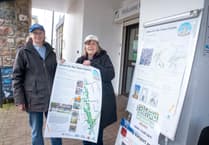FORMER mines surveyor Paul Morgan does not mince his words and says bluntly: “Any attempt to even investigate the possibilities of gas in or below the Forest of Dean coalfield would result in contamination and pollution of the area’s water supply, a situation which cannot be allowed to exist.”
Further, he calls on MP Mark Harper to apply his authority to stop any fracking proposals until a full technical and mining investigation has been carried out.
Here are copies of letters Mr Morgan has sent to the district council and the police.
To the district council planning officer: “On May 17, 2016 I attended a meeting arranged by the police and the engineers of South West Energy, who are proposing to carry out fracking operations in the Forest of Dean, probably a similar exercise to the one presented recently to your council.
“I have responded to the police on this event and enclose a copy which you may find useful with your deliberations on fracking in council.
“I am also enclosing a sketch section to assist in illustrating the situation.
“At the above mentioned meeting it was accepted that there was unlikely to be any gas in the coal measures but Mr Williams, South West Energy, stated that it was a position he would prove for himself with boreholes and that he had intention to bore much deeper into the Devonian rock to look for gas or even oil.
“You will see what I said in my letter (to the police). This is impossible.
“In drilling into the Devonian rock, direct connection will be made with both the Upper and Lower Series of coal measures and allow the transfer of contaminated, possibly poisonous, water between all three series, Upper, Lower, and Devonian (iron ore mines such as Shakemantle).
“Cllr Graham Morgan has on many occasions reported that when the water dropped at Shakemantle the springs at Lydbrook (which supplied water to the area for many years) showed a similar drop, being in the same strata beds. If a check had been made at Coleford, the same drop would have been found, again showing the interconnection of strata and water levels.
“GlaxoSmithKline Beechams have their own private water supply to this source and any pollution, contamination or even poisoning would be catastrophic to this firm as it would be on the entire Forest of Dean. With fracking this is far more of a possibility.
“Inevitably we come round to the Northern Quarter and the dangers of fracking to this development.
“As previously stated, to carry out fracking operations it is necessary to remove all existing water from the underground mines in order to hydraulically force the necessary chemicals, sand and cement etc into the bore holes to fracture the strata and release the shale gas. This will remove the varying water cushion pressures, currently supporting the excavated coal areas, possibly around 18 square miles or so of Lower Series mining, of anything from 20 to 80 atmospheres of existing water pressure and place the surface areas in danger of subsidence - remember Arthur and Edward Colliery (June 30, 1949) when an inrush of water resulted in damaged structures over a mile away and even gardens sinking.
“I have repeatedly stated that as long as the very high water pressure remained under the Northern Quarter there was little likelihood of subsidence but once this was removed there was no knowing what would happen.
“It will readily be seen that you, the district and county council urgently need to oppose and ban all fracking within the Forest of Dean in the intererst of safety, particularly with children entering the Northern Quarter site, and suspend any building activity. Until such times as the future of fracking is known the dangers are far too great and it would be political and professional suicide and certainly not common sense not to take such action.
“This is not a case of ‘suck it and see’. If it gets to this stage it is too late.”
Mr Morgan’s letter to the police: “Thank you for your invitation and the hospitality of your officers at the recent meeting to discuss fracking in the Forest. I am certain a lot of information was gleaned from this discussion by all present.
“I thought that the photographs I produced, together witgh the geological description of the coalfield, would have been sufficient to establish the non-existence of gas in this area, but can only accept Mr Williams’ intention that he will prove, for himself, with boreholes, the exact situation both in the coalfield and below the Devonian Series.
“I was also very surprised to see the number of boreholes already put down in the Coleford, Mile End and Berry Hill areas. I certainly had not heard of this work and I am yet again surprised that this activity has not leaked from both the Forest of Dean Planning Committee or The Forestry Commission who both must have been fully aware of this work going on. It poses other questions.
“From the photographs produced by Mr Williams, I am amazed to see the size of the lined boreholes, or rather wells, put down to extract gas. They must have been around a metre in diameter.
“In answer to my question, Mr Taylor, Mr Williams’ geologist, stated that there was no intention to pump water from the existing coalfield workings. This, on reflection after the meeting, I find impossible to accept.
“At the Northern Quarter, from the surface to the bottom of the Coleford Highdelf seam is some 900 feet with over 650 feet of flooded mine workings giving 20 atmospheres of water pressure. World War Two submarines collapsed and crumbled in this pressure so it is unlikely that borehole linings let alone drilling heads and equipment will stand up to these kind of conditions, and the impossibility of being able to introduce cement, sand and other necessary fracking chemicals into an already highly pressurised hydraulic environment, not to mention the deeper depths necessary to prove for shale gas below the coal measures. “In the deepest area of the coalfield some 50 to 60 atmospheres can be expected and once below the coalfield this figure could be doubled with water entering from the Upper Lower Series and iron ore mines such as Shakemantle.
“The flooded workings of both the Upper Series and Lower Series have always been separated with large clay beds, the former draining off at around 250 feet above sea level, and the latter at 67 above sea level at Old Norchard Colliery. Drilling the fracking wells from the surface will link and drain the two Series into one and upset the aquastatistics of the Forest of Dean with untold and unmanageable problems and pollution.
“Bearing in mind that Old Norchard, which drains from the Lower Series only, is discharging 5,000 gallons of water a minute into the River Lyd which with other 60 years of closed mines water stabilisation, also indicates that at least the same amount of water is being deposited from the surface, each minute, into the mine working.
“To give some idea of the water involved, 5,000 gallons of water would fill, in one week, Wembley Stadium to a height of 100 feet. Frightening!
“It is my opinion that to contemplate fracking in the Forest of Dean it is necessary to drain the mines of water, an impossible task in my view, and to tinker with the system could easily upset the natural and established water balance of the area not to mention local flooding. Such drainage would take very many wells to pump from and it should be remembered that all pumps must be within 25ft vertically of any suction point of any water point pick up.
“Currently the majority of mine water is discharged through the River Lyd but any significant increase could be catastrophic for Lydney, bearing in mind the existing, very limited profile of the Lyd and also the effects of tidal variations of the River Severn.
“Diverting any water through Ruspidge, Soudley and Blakeney could be equally catastrophic not to mention the possibilities of flooding the A48 at both Blakeney and Lydney locations.
“Taking water through Lydbrook is another no-go solution with the very dicey conditions and size of the existing culverts through the village.
“Drilling below the Coleford Highdelf coal seam level will tap and contaminate potable water supplies from Shakemantle iron ore mine, Lydbrook valley springs and very many others incliuding supplies to the Royal Forest Factory at Coleford.
“Finally comparisons were made by Mr Gerwyn Williams to South Wales mining areas where he had carried out fracking operations to which I commented that the Forest of Dean was unique. This was not said lightly. From the mining aspect alone we are totally different. The National Coal Board (NCB) in their heyday tried to inflict South Wales mining methods on Forest mines. The majority never worked and if they did not at all satisfactorily.”





Comments
This article has no comments yet. Be the first to leave a comment.